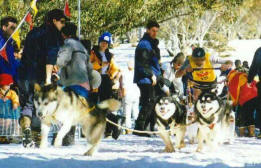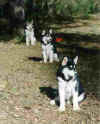|
 Understanding
the Alaskan Malamute: Temperament Understanding
the Alaskan Malamute: Temperament
 Dominance
& Pack Hierarchy
Dominance
& Pack Hierarchy
 Independence & Stubbornness
Independence & Stubbornness
 Interaction with other dogs & pets
Interaction with other dogs & pets
Because the Malamute was
required to live and work with any number of people in the Eskimo tribe,
they had to be a friendly dog that could be handled by any human adult
or child. Any dog that showed true aggression towards humans could not
be tolerated in such an environment, and would have been culled by the
Eskimos.
 This
aspect of the friendly Malamute temperament has thus been nurtured by
the Eskimos over thousands of years, and remains with the Malamutes we
have in our homes as pets today. Any serious aggression towards people
is unacceptable and should not be tolerated, however with indiscriminate
breeding with dogs of bad temperament, dogs not receiving the necessary
discipline, and ignorant breeders releasing pups too young (under 8
weeks) to new homes, we are still seeing the occasional truly
people-aggressive Malamute. This
aspect of the friendly Malamute temperament has thus been nurtured by
the Eskimos over thousands of years, and remains with the Malamutes we
have in our homes as pets today. Any serious aggression towards people
is unacceptable and should not be tolerated, however with indiscriminate
breeding with dogs of bad temperament, dogs not receiving the necessary
discipline, and ignorant breeders releasing pups too young (under 8
weeks) to new homes, we are still seeing the occasional truly
people-aggressive Malamute.
Aggression
in this breed, however, is not to be confused with a dominant or protective
nature, or with the normal rough play and "mouthing" action of the
Malamute. Mouthing is an attention-seeking behaviour which should be
discouraged and trained out of the Malamute as a pup, but should not be mistaken
for biting. A truly people-aggressive Malamute is best off being put to
sleep.
Malamutes
are not suitable as guard dogs, although their appearance may act as a visual
deterrent to a stranger who is not familiar with the breed. Nor can Malamutes be
attack trained. It is reported that those who have tried to attack train this
breed had to use such extreme training methods in order to get the Malamute to
attack a human that the dogs became unpredictable and dangerous around all
people. Tampering with the Malamute's naturally friendly temperament is not to
be recommended - those seeking a dog for guarding or attack training purposes
are strongly advised to consider another breed.
TOP
OF PAGE
 Independence
& Stubbornness Independence
& Stubbornness
The
Malamute's independent and stubborn nature can also be attributed to its arctic
origins. To survive in the unforgiving arctic environment, a Malamute needed to
have the independence and stubbornness to act first and foremost to ensure its
own survival. A Malamute that obeyed the commands of the Eskimo to pull the sled
over thin ice, for example, would not live to pass this obedient characteristic
on to their offspring. In the original environment of the Malamute, it was the
independent-minded dog that put his own survival above the willingness to
blindly follow commands that lived to see another day.
The
Malamute's independent nature was also relied upon by the Eskimos for their
survival. For instance, in conditions of low visibility the dog team would have
to find its way home on instinct, unaided by instructions from the musher. A dog
that relied solely on commands from the musher had no place in such an
environment.
This
independent and stubborn streak remains with most Malamutes today, often causing
much frustration and grief to those wishing to achieve success in obedience and
related activities.
 The
Malamute, being extremely intelligent, will often progress in these areas
quite rapidly as a pup, often giving their owners false hope of achieving
great heights. However, the independent and easily bored nature of the
Malamute nearly always comes to the fore in good time, and it is only
those owners with exceptional patience, tolerance, adaptability, plenty of
time and understanding of the Malamute mind who will go on to succeed in
these activities. The
Malamute, being extremely intelligent, will often progress in these areas
quite rapidly as a pup, often giving their owners false hope of achieving
great heights. However, the independent and easily bored nature of the
Malamute nearly always comes to the fore in good time, and it is only
those owners with exceptional patience, tolerance, adaptability, plenty of
time and understanding of the Malamute mind who will go on to succeed in
these activities.
So,
unless you have boundless patience, love a challenge and are prepared for
regular disappointment, we do not recommend you get a Malamute solely for the
pursuit of achievement in obedience and related activities. Having said
that, it must be stressed that a Malamute owner must be prepared to participate
religiously in obedience with their puppy from an early age to ensure a
well-mannered dog as well as a good understanding of training techniques - a
necessity for any Malamute owner.
TOP
OF PAGE
 Dominance
& Pack Hierarchy Dominance
& Pack Hierarchy
The
Malamute is renowned for its potentially dominating nature and its strong pack
orientation, and this is one of the reasons is it not highly suitable as a first
dog. The Malamute is by nature a pack animal, and the owners, their children and
other animals (including cats) in the family will become the Malamute's
"pack".
The
Malamute will look at all creatures in the pack, human or otherwise, and
study their behaviour and their interaction with the Malamute in order to
determine everyone's place in the "pecking order". Those that
the Malamute sees as being in control, being firm but fair, and not
putting up with any nonsense will often earn the Malamute's respect and be
recognised by the Malamute as being someone in authority who is higher up
in the pecking order - that is the "alpha" or "pack
leader". The more the Malamute respects the individuals in the
family, the more likely he is to listen to them, obey their commands and
be a well behaved pet.
 There
are certain things you can do to help attain the alpha position: There
are certain things you can do to help attain the alpha position:
-
When
going through a gate or door you should go first and always make the
Malamute wait. Do not let the Malamute barge through ahead of you.
-
Do
not let the Malamute sit up on the couch or on the bed at your level, and
likewise don't sit or play with the dog on the floor - both indicate to the
Malamute that he or she is your equal.
-
Do
not feed the dog at the same time you are eating, always feed the dog after
you've eaten. In a dog pack the leaders would eat first followed by
the dogs on the next highest level in the pack.
-
Never
lose your temper with a dog - the dog considers this as a sign of weakness
and will lose respect for an owner who loses control. Remember that
dogs do not understand shouting or hitting as these are behaviours they
don't use to discipline each other.
-
Do
not play tug-of-war games with the Malamute, don't throw something and then
fetch it yourself because your dog did not, and do not roll around in play
with your Malamute on the ground - these are behaviours of a pack equal, not
a pack leader.
The
Malamute should be reprimanded (negative reinforcement) when necessary with a
quick and meaningful growl at the time the dog is committing the unwanted
behaviour. Dogs do not understand lengthy or delayed
"punishments", such as being locked in a shed or being disciplined
hours later for having pulled clothes off the line. They will sense from
your body language and voice that they have done something wrong, but won't know
what, so your attempt at punishment will not help correct the behaviour because
the dog does not associate their action with your reaction.
 Anyone
in the family who spoils and molly-coddles the Malamute, doesn't follow
through with commands, lets the Malamute have his way or is not confident
with the Malamute will quickly be recognised and relegated to a lower
position in the family pecking order. Those that fall into this category
will find that the Malamute is quick to take advantage of their weakness
at any opportunity and will often ignore their commands. Anyone
in the family who spoils and molly-coddles the Malamute, doesn't follow
through with commands, lets the Malamute have his way or is not confident
with the Malamute will quickly be recognised and relegated to a lower
position in the family pecking order. Those that fall into this category
will find that the Malamute is quick to take advantage of their weakness
at any opportunity and will often ignore their commands.
Your
position in the pecking order is nothing to do with size or sex, how loud
you can yell or how deep you voice is - it is purely based on how you
interact with your dog and how much respect your Malamute has for you
based on that interaction.
Ideally
everyone in the family, including children, should be above the Malamute in the
pecking order. The whole family needs to be firm, fair and consistent with their
treatment of the dog and know how to interact with the Malamute to discourage
unwanted behaviours and encourage good behaviours.
TOP
OF PAGE
Interaction
with other dogs
 The
friendliness of the Malamute towards people unfortunately does not always extend
towards other dogs, and this is one of the downsides to the breed. As with all
the instincts of the Malamute, this is not without reason and owners need to
understand this and take necessary precautions. The
friendliness of the Malamute towards people unfortunately does not always extend
towards other dogs, and this is one of the downsides to the breed. As with all
the instincts of the Malamute, this is not without reason and owners need to
understand this and take necessary precautions.
In
an arctic environment, a canine intruder on the Malamute's hunting territory
would mean sharing of a very scarce food supply, and in the case of a bitch, a
threat to the survival of her pups or future litter. For these reasons other
dogs not belonging to the pack could not be tolerated and needed to be dealt
with and either warned off or despatched by the Malamute.
Author: Sandy Koch, Windchill Kennels. |